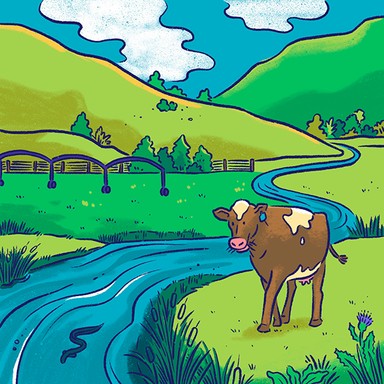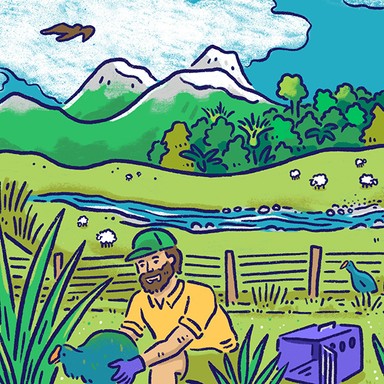
Greater Wellington Regional Council

Freshwater
The worsening state of New Zealand’s lakes and rivers is a major challenge for regional councils, which play a leading role in managing freshwater in their areas. To this end, regional councils create plans to protect water resources from contaminants and overuse.

Freshwater
The worsening state of New Zealand’s lakes and rivers is a major challenge for regional councils, which play a leading role in managing freshwater in their areas. To this end, regional councils create plans to protect water resources from contaminants and overuse.
Implement all recommendations in Te Whaitua te Whanganui-a-Tara Report (TWT) 9/2021 with pathways from highly degraded waterways to ecological health.
Deliver recommendations in 9/21 TWT Report to increase minimum flows in rivers to 80 percent of Mean Annual Low Flow (MALF) in 50 years and 100 percent MALF for streams.
Implement Te Mahere Waio Te Kāhui Taiao report (TWT) 9/2021 by Mana Whenua whānau implementation plan to return mana to our freshwater bodies.
Prioritise the regeneration of waterways to swimmable levels.
Provide support for land users to transition to sustainable practices that will protect our waterways and environment.
Lobby for reform in the water permit process to prevent commercial users from putting undue stress on our water supply.
Work with communities and catchment users to improve the health and swimability of rivers and streams.
Ensure that Te Mana o te Wai National Policy Statement is used as a baseline for all decisions.
Implement ecological solutions to stormwater management.
Effective implementation of the Whaitua recommendations. Work with local authorities and use regulatory and non-regulatory mechanisms.
Work with mana whenua to embed te mana o te Wao principles and concepts, to improve water quality in the region and set an exemplar for others.
Develop a spatial plan for the region as an integrated planning tool and balance urban growth with environmental management.
Stop district councils polluting rivers and the sea without being held to account either by the public or the courts.
Invest in better water quality measurement and monitoring to make decisions based on accurate data.
Finance urban freshwater security by supporting residential water tank installation and grey water systems.
Implement better checks, balances, and audit and enforcement to ensure compliance with water quality.
Aim to have all our waterways and coastal and marine areas to be pollution free by 2025.
Ensure the dumping of contaminants is undertaken using best practice techniques, and where failures occur, that rigid prosecutions occur.
Freshwater: implementing stronger control of water quality for our rivers and streams, led by community-engagement processes.
Wetlands: protecting more of our existing and lost wetlands – re-wetting, planting, protecting.
Water quantity: reducing consent limits for big water extractors – if you are not using your allocation then give back the portion not used.
Grant legal personhood to awa tupua such as the Kaiwharawhara stream. Allowing us to restore its mauri and the vital ecosystems within it.
Restore wetlands and urban streams as key elements of natural infrastructure that purify water, prevent erosion, flooding and drought.
Increase public education and communication around urban streams. Daylight them to create enjoyable places that can also mitigate flooding.
Ensure our freshwater is protected, sustainable and of the highest quality.
Support the active involvement of tangata whenua in the decision-making, planning and policy development for freshwater management!
Grant legal personhood to awa tupua such as the Kaiwharawhara stream allowing us to restore its mauri and the vital ecosystems within them.
Connect people in Wellington to the urban streams that run beneath our feet through public education, communication and signage.
Restore wetlands and urban streams as key elements of natural infrastructure that purify water, prevent erosion, flooding and drought.
Implement all recommendations in Te Whaitua te Whanganui-a-Tara Report (TWT) 9/2021 with pathways from highly degraded waterways to ecological health.
Deliver recommendations in 9/21 TWT Report to increase minimum flows in rivers to 80 percent of Mean Annual Low Flow (MALF) in 50 years and 100 percent MALF for streams.
Implement Te Mahere Waio Te Kāhui Taiao report (TWT) 9/2021 by Mana Whenua whānau implementation plan to return mana to our freshwater bodies.
Prioritise the regeneration of waterways to swimmable levels.
Provide support for land users to transition to sustainable practices that will protect our waterways and environment.
Lobby for reform in the water permit process to prevent commercial users from putting undue stress on our water supply.
Work with communities and catchment users to improve the health and swimability of rivers and streams.
Ensure that Te Mana o te Wai National Policy Statement is used as a baseline for all decisions.
Implement ecological solutions to stormwater management.
Effective implementation of the Whaitua recommendations. Work with local authorities and use regulatory and non-regulatory mechanisms.
Work with mana whenua to embed te mana o te Wao principles and concepts, to improve water quality in the region and set an exemplar for others.
Develop a spatial plan for the region as an integrated planning tool and balance urban growth with environmental management.
Stop district councils polluting rivers and the sea without being held to account either by the public or the courts.
Invest in better water quality measurement and monitoring to make decisions based on accurate data.
Finance urban freshwater security by supporting residential water tank installation and grey water systems.
Implement better checks, balances, and audit and enforcement to ensure compliance with water quality.
Aim to have all our waterways and coastal and marine areas to be pollution free by 2025.
Ensure the dumping of contaminants is undertaken using best practice techniques, and where failures occur, that rigid prosecutions occur.
Freshwater: implementing stronger control of water quality for our rivers and streams, led by community-engagement processes.
Wetlands: protecting more of our existing and lost wetlands – re-wetting, planting, protecting.
Water quantity: reducing consent limits for big water extractors – if you are not using your allocation then give back the portion not used.
Grant legal personhood to awa tupua such as the Kaiwharawhara stream. Allowing us to restore its mauri and the vital ecosystems within it.
Restore wetlands and urban streams as key elements of natural infrastructure that purify water, prevent erosion, flooding and drought.
Increase public education and communication around urban streams. Daylight them to create enjoyable places that can also mitigate flooding.
Ensure our freshwater is protected, sustainable and of the highest quality.
Support the active involvement of tangata whenua in the decision-making, planning and policy development for freshwater management!
Grant legal personhood to awa tupua such as the Kaiwharawhara stream allowing us to restore its mauri and the vital ecosystems within them.
Connect people in Wellington to the urban streams that run beneath our feet through public education, communication and signage.
Restore wetlands and urban streams as key elements of natural infrastructure that purify water, prevent erosion, flooding and drought.
Mayor
Compare the mayoral candidates in your area
Local council
Compare the candidates for your city or district council
Regional council
Compare the candidates for your regional council
Local board
Compare the candidates for your local or community board






